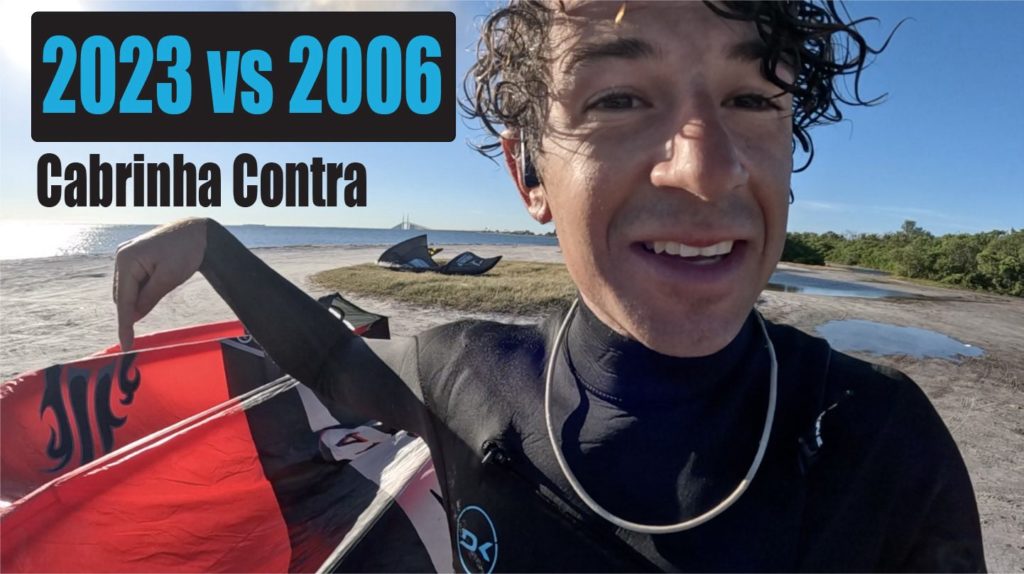Allgemein
Alte Kites vs neue Kites
Alte Kites vs neue Kites: Die wichtigsten Unterschiede
Alte Kites vs neue Kites
- Komplexe Bridle-Systeme: Alte Kites hatten oft lange und komplizierte Bridle-Systeme.
- Mehr Struts: Die Kites waren schwerer und weniger aerodynamisch.
- Quadratische Formen: Das Design war weniger effizient.
- Kontrollbars: Alte Kontrollbars hatten höhere Bar-Druckwerte, was das Lenken anstrengender machte.
- Leistung: Engere Windbereiche, langsameres Drehen, weniger Depower und eine geringere Präzision.
Alte Kites vs Neue Kites
- Verbesserte Aerodynamik: Modernere Designs ermöglichen präziseres Fliegen.
- Einfachere Bridle-Systeme: Weniger Komplexität macht die Bedienung einfacher.
- Weniger Struts: Neue Materialien ermöglichen leichtere und stabilere Kites.
- Performance: Leichter Bar-Druck, schnelleres Drehen, mehr Depower und ein intuitiveres Gefühl für die Kiteposition.
2023 Cabrinha Contra vs. 2006 Cabrinha Contra
Der Unterschied zwischen einem alten und einem neuen Kite wird bereits nach 60 Sekunden Fliegen deutlich. Hier die wichtigsten Punkte im Vergleich:
1. Bar-Druck
Der 2006er Kite hatte deutlich mehr Bar-Druck, was auf Dauer unangenehm ist. Moderne Kites wie der 2023er Cabrinha Contra haben leichten Bar-Druck, was das Kitesurfen komfortabler macht – besonders für Anfänger.
2. Wendigkeit
Ein moderner Kite wie der 15m Cabrinha Contra 2023 reagiert viel schneller als das 14m Modell von 2006. Während das alte Modell mehrere Sekunden Verzögerung hatte, ist das neue Modell fast unmittelbar reaktionsfähig.
3. Depower
Moderne Kites haben ein breiteres Windfenster. Beim 2023er Modell reduziert sich der Zug spürbar, wenn man die Bar nach vorne schiebt – ideal bei Windböen. Beim 2006er Kite blieb der Zug trotz Depower bestehen.

Alte Kites vs neue Kites
Gebrauchte Kites kaufen: Was du beachten solltest
Der Kauf gebrauchter Kites kann eine gute Möglichkeit sein, Geld zu sparen. Aber Vorsicht: Ältere Modelle bieten nicht die Sicherheit und Performance moderner Kites. Hier sind einige Punkte, die du beachten solltest:
1. Zustand des Kites
- Visuelle Prüfung: Achte auf Risse, Löcher und abgenutzte Stellen im Material. Ein neuwertiger Kite hat oft eine glänzende Oberfläche, während ältere Kites ausgeblichen wirken.
- Bladder: Prüfe auf Lecks oder Schäden.
- Bridle-Leinen: Fransen, Dehnungen oder Beschädigungen können teuer zu reparieren sein.
2. Kontrollbar und Leinen
- Achte auf Verschleiß oder Beschädigungen an Bar und Leinen.
3. Geschichte des Kites
- Frage nach Nutzungshäufigkeit, Reparaturen und Bedingungen, unter denen der Kite verwendet wurde (z. B. Salzwasser).
4. Sicherheit
- Stelle sicher, dass alle Sicherheitssysteme (z. B. Quick-Release) funktionieren.
5. Preis
- Verhandle den Preis basierend auf Zustand und möglichen Reparaturen.
Fazit
Moderne Kites haben sich in den letzten Jahren stark weiterentwickelt und bieten eine deutlich bessere Performance und Sicherheit. Egal ob Anfänger oder Profi – neue Modelle wie der Cabrinha Switchblade machen Kitesurfen einfacher und angenehmer. Beim Kauf gebrauchter Kites solltest du jedoch immer auf Zustand und Sicherheitsfunktionen achten, um das Beste aus deinem Kitesurf-Erlebnis herauszuholen.
Hast du noch Fragen? Schreib uns einfach eine Nachricht!

